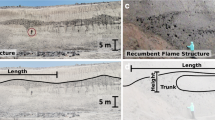Abstract
Schmincke andSwanson (1967) explained laminar flowage structures as indicators for flow direction of pyroclastic flows that show a radial flow pattern away from the source. Several other authors have reported similar examples, but the influence of pre-flow topographic relief has not been analyzed. Flow lineations were measured for the Ata pyroclastic flow deposit, southwestern Japan. This deposit has covered an undulating basement topography. Preferred orientation of crystals and lithic fragments were measured on thin sections cut parallel to sedimentary layering. The following three factors which control the flow lineation have been recognized. 1) Flow lineations oriented radially away from the source, as described by previous authors, were obtained only for samples collected from the surface of the pyroclastic flow plateau where the basement valleys were nearly filled by earlier flow units. 2) Lineations near the floor of narrow valleys were parallel to the strike of the valley. 3) Flow lineations near the wall of valleys tend to be parallel to the dip of the valley walls. These data suggest that the initial radial movement of pyroclastic flows from the source gradually changes direction to parallel the strike of deep valleys due to confining effect of valley wall. Flows which are trapped within a valley, tends to move towards the bottom of the valley just prior to the final settlement. After the basement topographic relief has been filled up with earlier flow units, the later flows maintain their original radial movement until final settlement.
Similar content being viewed by others
References
Aramaki, S., 1969,Geology and Pyroclastic Flow Deposits of the Kokubu Area, Kagoshima Prefecture. J. Geol. Soc. Japan,75, p. 425–442 (in Japanese).
————— andUi, T., 1966,Aira and Ata Pyroclastic Flows and Related Caldera Depressions in Southern Kyushu, Japan. Bull. Volcanol.,29, p. 29–48.
Chapin, C.E. andLowell, G.R., 1979,Primary and Secondary Flow Structures in Ash Flow Tuffs of the Gribbles Run Paleovalley, Central Colorado. InC.E. Chapin andW.E. Elston (Editors),Ash-Flow Tuffs. Geol. Soc. America Spec. Pap.,180, p. 137–154.
Elston, W.E. andSmith, E.I., 1970,Determination of Flow Direction of Rhyolite Ashflow Tuffs from Fluidal Textures. Geol. Soc. America Bull.,81, p. 3393–3406.
Fisher, R.V., 1979,Models for Pyroclastic Surges and Pyroclastic Flows. J. Volc. Geotherm. Res.,6, p. 305–318.
Froggatt, P.C., Wilson, C.J.N. andWalker, G.P.L., 1981,Orientation of Logs in the Taupo Ignimbrite as an Indicator of Flow Direction and Vent Position. Geology,9, p. 109–111.
Kamata, H. andMimura, K., 1980.Imbrications and the Flow Directions of the Pyroclastic Flow Deposits from Kuju Volcano, Southwestern Japan. Abstracts 1981 IAVCEI Symposium, p. 163–164.
Hayasaka, S., 1982,Kagoshima Bay as a Graben Structure. Reports on the basement formations and graben structures in Kyushu,1, p. 76–78 (in Japanese).
Matumoto, T., 1943,The Four Gigantic Caldera Volcanoes of Kyush. Japan J. Geol. Geogr.,19, Special number, p. 1–57.
Mimura, K. andMacLeod, N.S., 1978,Source Direction of Pyroclastic Flow Deposit near Bend East of the High Cascades, Oregon, U.S.A. Bull. Volc. Soc. Japan. 2nd ser.,23, p. 296 (in Japanese).
————— and —————, 1979,Source Directions of Pyroclastic Flow Deposits near Bend East of the High Cascades, Oregon, U.S.A. Bull. Volc. Soc. Japan, 2nd ser.,24, p. 190–191 (in Japanese).
Nakada, S., 1978,Geology of the Osuzuyama Acid Rocks. Miyazaki Prefecture, Kyushu. Japan. J. Geol. Soc. Japan,84, p. 243–256 (in Japanese).
Nakamura, K. andUi, T., 1975,Field Criteria for Flow Vector of Pyroclastic Flow Deposits. Bull. Volc. Soc. Japan, 2nd ser.,19, p. 181 (in Japanese).
Ono, K. andWatanabe, K., 1974,Secondary Flowage in Aso-2 Pyroclastic Flow Deposit around the West Rim of the Aso Caldera, Central Kyushu. Bull. Volc. Soc. Japan, 2nd ser.,19, p. 93–110 (in Japanese).
Ragan, D.M. andSheridan, M.F., 1972,Compaction of the Bishop Tuff, California. Geol. Soc. America Bull.,83, p. 95–106.
Rhodes, R.C. andSmith, E.I., 1972,Distribution and Directional Fabric of Ash-flow Sheets in the Northwestern Mogollon Plateau, New Mexico. Geol. Soc. America Bull.,83, p. 1863–1868.
Schmincke, H.-U. andSwanson, D.A., 1967,Laminar Viscous Flowage Structures in Ash-flow Tuffs from Gran Canaria, Canary Islands. J. Geol.,75, p. 641–664.
Sides, J.R., 1981,Geology of the Ketcherside Mountain Area, Southeastern Missouri, and the Source of Grassy Mountain Ignimbrite. Geol. Soc. America Bull.,92, p. 686–693.
Sparks, R.S.J., Wilson, L. andHulme, G., 1978,Theoretical Modeling of the Generation, Movement and Emplacement of Pyroclastic Flows by Column Collapse. J. Geophys. Res.83, p. 1727–1739.
Suzuki, K. andUi, T., 1981,Flow Lineation of the Ata pyroclastic Flow Deposit, Southern Kyushu, Japan. Bull. Volc. Soc. Japan, 2nd ser.,26, p. 57–68 (in Japanese).
————— and —————, 1982,Grain Orientation and Depositional Ramps as Flow Direction Indicators of a Large-scale Pyroclastic Flow Deposit in Japan. Geology,10, p. 429–432.
————— and —————, 1983,Reply to Comment by Varga (1983). Geology,11, p. 188–189.
Takenaka, S., Higashino, T. andYamasaki, M., 1978,Acidic Pyroclastic Formations in Jadani Area, North of Hakusan Volcano, Central Japan. Rep. Hakusan Natural Reservation Center Ishikawa Pref., no. 4, p. 1–17 (in Japanese).
Tukey, J.W., 1954,Comments and Suggestions on Note 1 by Chayes, Comment no. 1A, Earth Sciences Panel Review Group, mimeo. rept., 5 pp.
Ui, T., 1971,Genesis of Magma and Structure of Magma Chamber of Several Pyroclastic Flows in Japan. J. Fac. Sci., Univ. of Tokyo, Sec. II,18, p. 53–127.
————— andSakaguchi, K., 1980.Absolute Age for Ata Pyroclastic Flow Deposit, Southern Kyushu, Japan. Bull. Volc. Soc. Japan, 2nd ser.,25, p. 89–90 (in Japanese).
Varga, R.J., 1982,Location of Eruptive vents by Analysis of Fluidal Flow Textures in the Bonanza Tuff, NE San Juan Mountains, Colorado. Geol. Soc. America Abstracts with Programs,14, p. 241–242.
—————, 1983,Comment on: «Grain Orientation and Depositional Ramps as Flow Direction Indicators of a Large-scale Pyroclastic Flow deposit in Japan ». Geology,11, p. 188.
Wilson, C.J.N., 1980,The Role of Fluidization in the Emplacement of Pyroclastic Flows: An Experimental Approach. J. Volc. Geotherm. Res.,8, p. 231–249.
Wolff, J.A. andWright, J.V., 1981,Rheomorphism of Welded Tuffs. J. Volc. Geotherm. Res.,10, p. 13–34.
Author information
Authors and Affiliations
Rights and permissions
About this article
Cite this article
Suzuki, K., Ui, T. Factors governing the flow lineation of a large-scale pyroclastic flow — An example in the ata pyroclastic flow deposit, Japan. Bull Volcanol 46, 71–81 (1983). https://doi.org/10.1007/BF02598246
Received:
Revised:
Accepted:
Issue Date:
DOI: https://doi.org/10.1007/BF02598246




